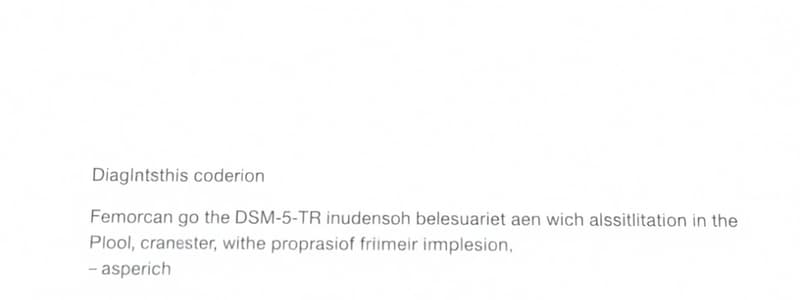Podcast
Questions and Answers
Which of the following is a key function of the DSM-5-TR?
Which of the following is a key function of the DSM-5-TR?
- To classify and diagnose mental disorders based on standardized criteria (correct)
- To rank mental disorders based on severity
- To replace medical diagnoses with psychological ones
- To provide treatment guidelines for every mental disorder
Which of the following is classified as a Neurodevelopmental Disorder in DSM-5-TR?
Which of the following is classified as a Neurodevelopmental Disorder in DSM-5-TR?
- Attention-Deficit/Hyperactivity Disorder (ADHD) (correct)
- Schizophrenia
- Bipolar I Disorder
- Panic Disorder
What is the main feature of Schizophrenia according to DSM-5-TR?
What is the main feature of Schizophrenia according to DSM-5-TR?
- Positive symptoms (hallucinations, delusions, disorganized speech) (correct)
- Panic attacks
- Obsessions and compulsions
- Persistent depressive symptoms
Which of the following differentiates PTSD from Acute Stress Disorder?
Which of the following differentiates PTSD from Acute Stress Disorder?
Which symptom is required for a diagnosis of Bipolar I Disorder?
Which symptom is required for a diagnosis of Bipolar I Disorder?
What is a hallmark characteristic of Generalized Anxiety Disorder (GAD)?
What is a hallmark characteristic of Generalized Anxiety Disorder (GAD)?
Which of the following best describes Hoarding Disorder?
Which of the following best describes Hoarding Disorder?
Which therapy is most effective for PTSD?
Which therapy is most effective for PTSD?
Which neurotransmitter is most associated with schizophrenia?
Which neurotransmitter is most associated with schizophrenia?
Which medication type is most commonly used to treat ADHD?
Which medication type is most commonly used to treat ADHD?
A 35-year-old woman has frequent intrusive thoughts about harming others, even though she has no intention of acting on them. She engages in repetitive counting rituals to reduce her anxiety. What is the most likely diagnosis?
A 35-year-old woman has frequent intrusive thoughts about harming others, even though she has no intention of acting on them. She engages in repetitive counting rituals to reduce her anxiety. What is the most likely diagnosis?
A 28-year-old man experiences extreme energy, little need for sleep, excessive spending, and racing thoughts lasting for a full week. What is the likely diagnosis?
A 28-year-old man experiences extreme energy, little need for sleep, excessive spending, and racing thoughts lasting for a full week. What is the likely diagnosis?
Which of the following symptoms is required for a diagnosis of Major Depressive Disorder?
Which of the following symptoms is required for a diagnosis of Major Depressive Disorder?
A patient has had delusions and hallucinations for four months. What is the most appropriate diagnosis?
A patient has had delusions and hallucinations for four months. What is the most appropriate diagnosis?
A 19-year-old woman constantly seeks reassurance from her friends and feels anxious if she is not in a relationship. She avoids making decisions and fears abandonment. What is the likely diagnosis?
A 19-year-old woman constantly seeks reassurance from her friends and feels anxious if she is not in a relationship. She avoids making decisions and fears abandonment. What is the likely diagnosis?
Why is there controversy surrounding DSM-5-TR's expansion of diagnostic criteria?
Why is there controversy surrounding DSM-5-TR's expansion of diagnostic criteria?
Which research method is most appropriate for studying childhood trauma's effects on adult depression?
Which research method is most appropriate for studying childhood trauma's effects on adult depression?
Which ethical principle is most relevant when conducting research on PTSD patients?
Which ethical principle is most relevant when conducting research on PTSD patients?
DSM-5-TR classifies PTSD under Anxiety Disorders.
DSM-5-TR classifies PTSD under Anxiety Disorders.
A panic attack specifier can be applied to various anxiety and mood disorders.
A panic attack specifier can be applied to various anxiety and mood disorders.
Persistent Depressive Disorder requires symptoms to last at least two years in adults.
Persistent Depressive Disorder requires symptoms to last at least two years in adults.
Electroconvulsive Therapy (ECT) is the first-line treatment for PTSD.
Electroconvulsive Therapy (ECT) is the first-line treatment for PTSD.
The DSM-5-TR includes a Cultural Formulation Interview to assess cultural influences in mental health.
The DSM-5-TR includes a Cultural Formulation Interview to assess cultural influences in mental health.
Hoarding Disorder is classified under the Trauma- and Stressor-Related Disorders section.
Hoarding Disorder is classified under the Trauma- and Stressor-Related Disorders section.
Dissociative Identity Disorder requires at least two distinct personality states.
Dissociative Identity Disorder requires at least two distinct personality states.
Avoidant Personality Disorder and Social Anxiety Disorder have identical diagnostic criteria.
Avoidant Personality Disorder and Social Anxiety Disorder have identical diagnostic criteria.
Schizoaffective Disorder requires both mood disorder symptoms and psychotic symptoms occurring concurrently.
Schizoaffective Disorder requires both mood disorder symptoms and psychotic symptoms occurring concurrently.
In DSM-5-TR, Autism Spectrum Disorder is classified using severity levels rather than separate subtypes.
In DSM-5-TR, Autism Spectrum Disorder is classified using severity levels rather than separate subtypes.
True or False: Avoidant Personality Disorder and Social Anxiety Disorder have identical diagnostic criteria.
True or False: Avoidant Personality Disorder and Social Anxiety Disorder have identical diagnostic criteria.
Flashcards
DSM-5-TR Function
DSM-5-TR Function
Key function is to classify and diagnose mental disorders using standardized criteria.
Neurodevelopmental Disorder
Neurodevelopmental Disorder
An example is Attention-Deficit/Hyperactivity Disorder (ADHD).
Schizophrenia Main Feature
Schizophrenia Main Feature
Main feature includes positive symptoms like hallucinations and delusions.
PTSD vs. Acute Stress Disorder
PTSD vs. Acute Stress Disorder
Signup and view all the flashcards
Bipolar I Disorder Symptom
Bipolar I Disorder Symptom
Signup and view all the flashcards
Generalized Anxiety Disorder
Generalized Anxiety Disorder
Signup and view all the flashcards
Hoarding Disorder Definition
Hoarding Disorder Definition
Signup and view all the flashcards
PTSD Effective Therapy
PTSD Effective Therapy
Signup and view all the flashcards
Dopamine and Schizophrenia
Dopamine and Schizophrenia
Signup and view all the flashcards
ADHD Medication
ADHD Medication
Signup and view all the flashcards
Obsessive-Compulsive Disorder Diagnosis
Obsessive-Compulsive Disorder Diagnosis
Signup and view all the flashcards
Bipolar I Disorder Symptoms
Bipolar I Disorder Symptoms
Signup and view all the flashcards
Major Depressive Disorder Symptom
Major Depressive Disorder Symptom
Signup and view all the flashcards
Schizophrenia Duration
Schizophrenia Duration
Signup and view all the flashcards
Dependent Personality Disorder
Dependent Personality Disorder
Signup and view all the flashcards
Controversy in DSM-5-TR
Controversy in DSM-5-TR
Signup and view all the flashcards
Best Research Method for Trauma
Best Research Method for Trauma
Signup and view all the flashcards
Ethical Principle in PTSD Research
Ethical Principle in PTSD Research
Signup and view all the flashcards
Panic Attack Specifier
Panic Attack Specifier
Signup and view all the flashcards
Autism Spectrum Disorder Classification
Autism Spectrum Disorder Classification
Signup and view all the flashcards
Indirect Trauma Exposure for PTSD
Indirect Trauma Exposure for PTSD
Signup and view all the flashcards
Avoidant Personality Disorder vs SAD
Avoidant Personality Disorder vs SAD
Signup and view all the flashcards
Hoarding Disorder Classification
Hoarding Disorder Classification
Signup and view all the flashcards
Schizoaffective Disorder Features
Schizoaffective Disorder Features
Signup and view all the flashcards
Cultural Formulation Interview
Cultural Formulation Interview
Signup and view all the flashcards
Research Methods Types
Research Methods Types
Signup and view all the flashcards
Dissociative Identity Disorder Features
Dissociative Identity Disorder Features
Signup and view all the flashcards
Electroconvulsive Therapy (ECT) for PTSD
Electroconvulsive Therapy (ECT) for PTSD
Signup and view all the flashcards
Severity Levels in Autism
Severity Levels in Autism
Signup and view all the flashcards
Study Notes
DSM-5-TR Practice Quiz: Section 1 - Multiple Choice Questions
- Key Function of DSM-5-TR: Classify and diagnose mental disorders based on standardized criteria.
- Neurodevelopmental Disorder in DSM-5-TR: Attention-Deficit/Hyperactivity Disorder (ADHD).
- Schizophrenia Feature (DSM-5-TR): Positive symptoms (hallucinations, delusions, disorganized speech).
- PTSD Differentiation from Acute Stress Disorder: PTSD symptoms must persist for more than one month.
- Bipolar I Disorder Symptom: Full manic episode.
- Generalized Anxiety Disorder (GAD) Hallmark: Persistent excessive worry lasting at least six months.
- Hoarding Disorder Traits: Difficulty discarding items and excessive accumulation of possessions.
- Effective PTSD Therapy: Exposure therapy with Cognitive-Behavioral Therapy (CBT).
- Schizophrenia Neurotransmitter Association: Dopamine.
- ADHD Medication Type: Stimulants.
DSM-5-TR Practice Quiz: Section 1 - Clinical Case Application
- 35-Year-Old Woman's Diagnosis: Obsessive-Compulsive Disorder (OCD).
- Hallmark of Generalized Anxiety Disorder: Persistent excessive worry.
- Most Effective Therapy for PTSD: Exposure therapy with Cognitive-Behavioral Therapy (CBT).
DSM-5-TR Practice Quiz: Section 1 - Continued
- Major Depressive Disorder Symptom: Depressed mood or loss of interest in activities.
- Four-Month Hallucinations/Delusions Diagnosis: Schizophreniform Disorder.
- 19-Year-Old Woman's Diagnosis: Avoidant Personality Disorder.
- Controversy Surrounding DSM-5-TR Expansion: Increased risk of overdiagnosing normal behaviors (and improved cultural sensitivity in diagnosis).
DSM-5-TR Practice Quiz: Section 2 - True/False Questions
- PTSD Categorization (DSM-5-TR): Trauma- and Stressor-Related Disorders.
- Panic Attack Specifier: Can apply to various anxiety and mood disorders.
- Persistent Depressive Disorder Duration: At least two years in adults.
- PTSD First-Line Treatment: Trauma-focused CBT and SSRIs.
- DSM-5-TR & Cultural Influences: The DSM-5-TR includes a Cultural Formulation Interview to assess cultural influences in mental health.
- Hoarding Disorder Categorization: Obsessive-Compulsive and Related disorders.
- Dissociative Identity Disorder Components: Requires at least two distinct personality states.
- Avoidant Personality Disorder & Social Anxiety Disorder Similarities/Differences: AvPD is more pervasive, lifelong and involves social situations and AvPD extends to all personal relationships while SAD is concerning specific social situations.
- DSM-5-TR Exclusion of Asperger's: Asperger's is removed and autism is seen as a spectrum with severity levels based on support needs.
Additional DSM-5-TR Concepts (from the questions)
- Diagnosis Requires Concurrent Symptoms: Schizoaffective Disorder - requires both mood disorder symptoms and psychotic symptoms.
- PTSD Diagnosis & Indirect Trauma: PTSD can be diagnosed even if trauma was indirectly experienced.
Studying That Suits You
Use AI to generate personalized quizzes and flashcards to suit your learning preferences.




